|

by Igor Gontcharov
October
2014
from
AncientScienceArtifatcs Website
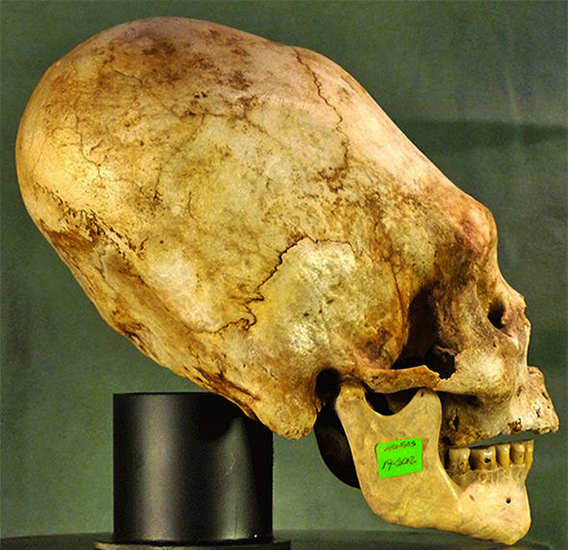
Part 1
Un/Born with Elongated Head
October 13, 2014
In one of our earlier
posts we presented reconstructions/interpretations of a large number
of elongated
skulls belonging to children.
While tracing the origins
of the artificial cranial deformation paradigm, we noticed an
earlier attempt to challenge its universality.
Here is a quote from
"Types of Mankind" (1854) by Nott and Gliddon:
Finally, the
"Peruvian Antiquities" of Rivero and Tschudi corroborate the
above scientific view, viz., that the artificial disfigurement
of the skull among the Inca-Peruvians and other South American
families, owes its origin to the prior existence of an
autocthonous race, in whose crania such (to us, seemingly) a
deformity was natural.
And thus the
contradictory materials which induced Dr. Morton at first to
deem this peculiarity to be congenital, and afterwards so
exclusively artificial, become reconciled; while due
regard is preserved to his truthful candor and craniological
acumen.
This is the evidence that
Rivero (Mariano
Eduardo De Rivero y Ustariz) and Tschudi (Johann
Jakob von Tschudi) in
Peruvian Antiquities (1853
English) and
Antiguedades Peruanas (1851
Spanish), offer to support their claim that,
elongated heads were
a natural phenomenon for certain Peruvian
tribes...
Thus, artificial cranial
deformation originated in an attempt to emulate the outward
appearance, or possibly certain mental/psychic qualities of the
"elongated heads" by tribes with "normal" head shape.
Rivero and Tschudi
criticized the protagonists of the hypothesis that artificial
cranial deformation was the only way to explain the existence
of elongated skulls, pointing out that such views were based
exclusively on the observation of adult skulls.
Meanwhile, they noted
that the mummies of two infants had become available to the
scientific community in England.
Also,
the
Catholic Church had started
to officially 'regulate' the practice of artificial cranial
deformation in the sixteenth century.
The [...] question is
of great importance, seeing that from its resolution the proof
is drawn, whether the formation of the crania is or is not the
result of mechanical pressure.
Many physiologists,
as it would seem, generally consider these forms anomalous, and
as an effect produced on the heads of children entirely by
pressure with small boards, or broad swathes, with which it was
usual to squeeze the crania of infants.
It is notorious
enough that such a practice did obtain among various
barbarous nations of the New World; and that it existed
among the Chinchas for the sake of producing distinctive marks
in families; an abuse which was 'forbidden' by an
apostolic bull in the sixteenth century.
But, in our opinion,
those physiologists are undoubtedly in error, who suppose that
the different phrenological aspects offered by the Peruvian race
were exclusively artificial.
This hypothesis rests
on insufficient grounds; its authors could have made their
observations solely on the crania of adult individuals, as it is
only a few years since two mummies of children were carried to
England, which, according to the very exact description of Dr.
Bellamy, belonged to the tribe of Aymaraes.
The two crania (both
of children scarce a year old) had, in all respects, the same
form as those of adults.
Now here comes the
evidence which, as we presently understand, was overlooked if not
suppressed for the past 164 years and needs to be re-examined.
Rivero and Tschudi
continue:
We ourselves have
observed the same fact in many mummies of children of tender
age, who, although they had cloths about them, were yet without
any vestige or appearance of pressure of the cranium.
More still:
the same
formation of the head presents itself in children yet
unborn; and of this truth we have had convincing proof in
the sight of a foetus, enclosed in the womb of a mummy of a
pregnant woman, which we found in a cave of Huichay, two
leagues from Tarma, and which is, at this moment, in our
collection.
Professor
D'Outrepont, of great Celebrity in the department of
obstetrics, has assured us that the foetus is one of seven
months' age.
It belongs,
according to a very clearly defined formation of the
cranium, to
the tribe of the Huancas...
We present the reader
with a drawing of this conclusive and interesting proof in
opposition to the advocates of mechanical action as the sole and
exclusive cause of the phrenological form of the Peruvian
race.
The same proof is to be found in another mummy which exists in
the museum of Lima, under the direction of Don M.E. de Rivero.
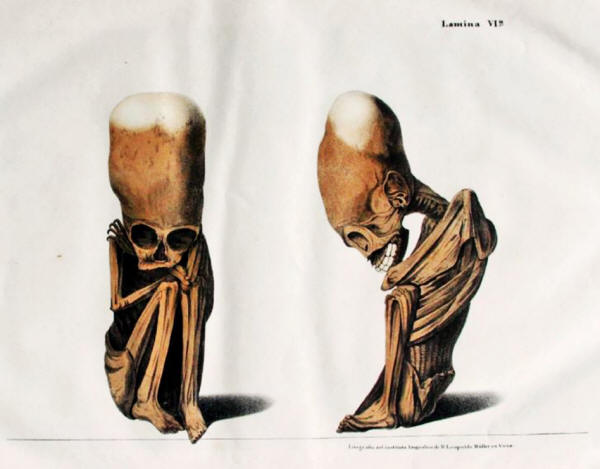
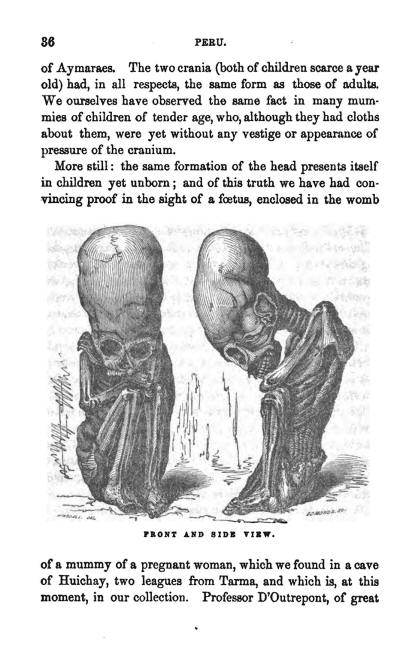
Color
images are from the
Spanish
(1851) edition of "Antigüedades peruanas",
which
has a corresponding illustrated Atlas
containing 58 lithographed color plates.
The
English edition contains
monochrome images only.
Part 2
Naturally Elongated
October
17, 2014
In the previous above post we provided evidence that some elongated
skulls were a natural phenomenon among certain Peruvian populations.
They were NOT a product
of artificial cranial deformation because the same elongated shape
was found in fetuses and infants. Here is the link to the gallery
containing reconstructions/interpretations of the skulls of infants
and children.
Before we provide more
evidence supporting this view, it is worth remembering that our task
is to trace the origins of the currently dominant artificial cranial
deformation paradigm, which explains ALL elongated skulls in terms
of deliberate reshaping of the natural form of the human skull.
Given the weight of the
emerging evidence in support of alternative interpretations, it is
not surprising that this dominant school of thought has acted in the
same way as many other mainstream paradigms - by excluding and
suppressing alternative views and solid new data, silencing and
ridiculing researchers who dare to challenge the established
"truth".
As was mentioned in our above previous post, in "Peruvian
Antiquities" (1851 Spanish, 1853 English) Rivero and
Tschudi presented two mummies - a fetus and an infant with
elongated heads.
This suggested that, at
least in some cases, elongated crania constituted a natural feature
and not a product of artificial deformation.
These mummies were found
in Peru and, at the time the book was written, remained in South
America.
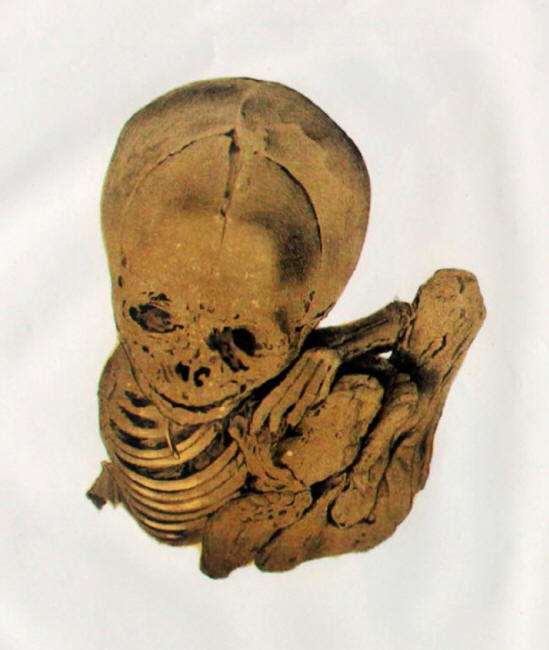

It is equally important to draw our readers' attention to the fact
that, in the excerpt below, Rivero and Tschudi help us to establish
that European researchers had this evidence in their possession
since 1841...!
In retrospect, it seems
that by 1851 many other scientists could have verified that the
elongated skulls of infants and adults were similar.
However, that would have
obviously led to questioning the universality of the cranial
deformation hypothesis, so it would appear that most scientists
chose to look the other way.
We strongly believe that,
had the evidence at hand been properly examined at the time, we
would not be having this debate today as it would have been
undoubtedly established that, in many cases, the artificial cranial
deformation hypothesis was untenable.
This is what Rivero and
Tschudi wrote:
This hypothesis [i.e.
artificial cranial deformation] rests on insufficient grounds.
Its authors could
have made their observations solely on the crania of adult
individuals, as it is only a few years since two mummies of
children were carried to England, which, according to the very
exact description of Dr. Bellamy, belonged to the tribe of
Aymaraes.
The two crania (both
of children scarce a year old) had, in all respects, the same
form as those of adults.
And so we set to work to
locate Dr. Bellamy's description.
We indeed discovered that
Dr. Bellamy, who was a surgeon, presented his analysis of the
mummies to the Zoological Section of the British Association on
August 3, 1841.
It was subsequently
published in Vol. X (October 1842) of the 'Annals and Magazine of
Natural History' (attached at bottom page). Not surprisingly, his
account of the mummified remains of infants contradicted the
emerging mainstream consensus.
Moreover, Dr. Bellamy
challenged the artificial cranial deformation paradigm on several
levels!
Reading his presentation from the vantage point of 2014, we see that
Dr. Bellamy's pioneering research, albeit of tremendous importance
and supported by solid and accessible evidence, was quickly
dismissed and forgotten in favor of the emerging status quo on
elongated skulls.
He was challenged on the
basis of an artifact discovered with one of the mummies, which some
scholars viewed as a "head-binding device".
The proponents of the
cranial deformation hypothesis were quick to present this artifact
as proof of their correctness. The scope of this article does not
allow for a detailed analysis of their arguments, but below we cite
Bellamy's response to these critics.
The "mummies" (Dr. Bellamy retained this designation but noticed
that, in that particular case, he dealt with mummified remains) were
discovered and brought to England by Captain Blankley and handed
over to the Museum of the Devon and Cornwall Natural History Society
in 1838.
Dr. Bellamy suggested
that these mummified remains belonged to two infants - male and
female,
"one of which was not
more than a few months old, and the other could not be much more
than one year".
Here are the lithographs
of the skulls by J. Basire from the original publication
(1842) and Mark Laplume's reconstructions/interpretations
(2014).
Dr. Bellamy's analysis
is, indeed, very detailed, outlining important structural
differences.
For the purpose of this
article, we quote only the part in which he directly engages with
the cranial deformation hypothesis.
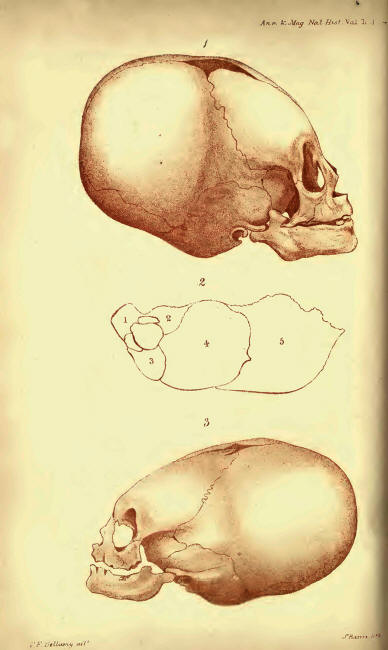
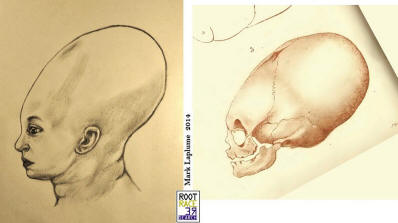 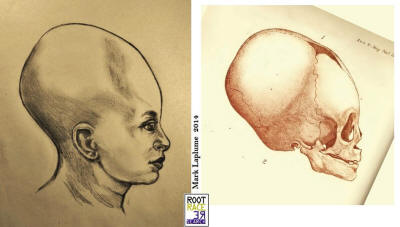
It will be manifest
from the general contour of these skulls that they are allied to
those in the Museum of the College of Surgeons in London,
denominated Titicacans.
Those adult skulls
are very generally considered to be distorted by the effects of
pressure; but in opposition to this opinion Dr. Graves has
stated, that,
"a careful
examination of them has convinced him that their peculiar
shape cannot be owing to artificial pressure",
...and to corroborate
this view, we may remark that the peculiarities are as great in
the child as in the adult, and indeed more in the younger than
in the elder of the two specimens now produced.
And the position is
considerably strengthened by the great relative length of the
large bones of the cranium, by the direction of the plane of the
occipital bone, which is not forced upwards, but occupies a
place in the under part of the skull, by the further absence of
marks of pressure, there being no elevation of the vertex nor
projection of either side; and by the fact of there being no
instrument nor mechanical contrivance suited to produce such an
alteration of form (as these skulls present) found in connection
with them.
Thus, not only is Dr.
Bellamy persuaded that these infants were not subjected to any form
of head-binding, but he also leads us to another disagreeing voice -
that of Dr. Graves.
Robert J. Graves,
M.D., King's Professor of the Institutes of Medicine, also had an
opportunity to examine Peruvian elongated skulls and concluded that,
"their peculiar shape
cannot be owing to artificial pressure".
This is actually a quote
from Mr. Pentland, with whom Dr. Graves was in agreement.
Dr. Graves' analysis can
be found in No.15 of the Dublin Journal of Medical and Chemical
Sciences, of which he was the editor.
Before we proceed to Dr. Graves, we would like to quote Dr. Bellamy
again.
He suggested that these
elongated skulls belonged to a race that occupied the vicinity of
Lake Titicaca prior to the arrival of settlers of Asiatic origin and
who were subsequently absorbed by the newcomers.
It is probable that
the extinction of this once typical variety of the human family
was produced gradually by an intermixture of blood with those
who afterwards became the lords of the soil, and whose line of
princes, untainted by such intercourse, formed the Incas dynasty
so remarkable in the history of Peru.
Lastly, I would suggest that the adult skulls of Titicacans
before alluded to are of two kinds, the one possessing all the
peculiarities of the race in its unalloyed form - the true
Titicacan.
And the other being
of a spurious character, resulting from the union of the
indigenae with the settlers of Asiatic origin, the companions of
Manco Capac of traditionary fame.
Accordingly in the
former we observe the receding forehead, the elongated cranium,
and the horizontally-placed occipital bone; and in the latter a
modified form, in which, combined with the receding forehead and
elongated cranium, there is an elevated vertex and flattened
occiput, formed principally by an altered position of the
occipital bone; which, instead of lying on a plane with the
horizon, rises in a sloping direction upwards and backwards to
meet the parietal bones.
Most importantly, in the
next passage Dr. Bellamy responds to a critic by providing three
reasons as to why the bandage found with the younger mummy could not
be used for cranial deformation.
We will return to this
account in one of our forthcoming posts because these enigmatic
devices accompanied several other mummies with elongated crania and
were used by the proponents of the artificial cranial deformation
theory as evidence in their favour.
After the reading of
this paper, Prof. Owen stated that he entertained an opinion
that their peculiar form was given to them by pressure, such as
might be applied by a bandage passed round the head; and he
suggested that a short fillet (about 16 inches long) found with
the younger of the two mummies might have been employed for this
purpose.
This bandage,
however, I consider was used to secure the lower extremities to
the trunk, and on consideration I am disposed to maintain the
same opinion as I have stated above:
-
1st, because
this fillet is but 1.5 inch wide, whereas the flattened
portion of the skull is more than 3 inches, extending
over the os frontis from immediately above the
superciliary ridges to an inch beyond the coronal
suture, so as to involve the anterior portion of the
parietal bones
-
2nd, the line
of depression in these skulls has a direction over the
middle of the os occipitis, and then over the anterior
third of the parietal bones, first where the angle dips
down between the frontal temporal bones, and then
immediately behind the coronal suture, and not at all
over the os frontis
-
3rd, because,
if pressure had been used in this direction, it would
have contracted the great fontanelle, of which there is
no mark whatever. Indeed in the elder of the two, in
which the depressed line is most visible, the fontanelle
is most open
-
Lastly, if a
circular bandage had been applied, it would have given a
circular form to that portion at least compressed by it
; whereas however a transverse section, taken by
measurement, shows that the skulls have a compressed
pyriform figure, the larger extremity representing the
flattened and upper surface, and the smaller
corresponding with the contracted aspect of the
occipital bone.
We conclude this
discussion with Dr. Graves' citations on the elongated skulls from
Bolivia which he observed in Paris, at the Museum of Comparative
Anatomy.
Below, Dr. Graves quotes
a communication from Mr. Pentland, who excavated the skulls in 1827.
Dr. Graves also cites a
reflection on Mr. Pentland's account by Tiedemann.
The singularly shaped
skulls which excited your attention, I obtained in 1827, in the
Province of Upper Peru, now called Bolivia.
They seem to belong
to an extinct race of mankind. I found them in the ancient
graves called Huacas, in the great alpine valley of Titicaca,
which is likewise remarkable for being the country in which
civilization, planted by the Peruvians, flourished to a degree
unrivaled among the other tribes of the new world.
These sepulchres have
the form of high round towers, and in some places are
constructed of enormous masses of masonry.
The stones are very
carefully and skilfully arranged, in a manner similar to that
observed in the old structures of Greece and Italy, named by our
antiquarians Cyclopean.
I have met them only
in the valley of Titicaca, which extends from the seventeenth to
the nineteenth degree of latitude (south), and on the skirts of
the Andes which form that valley.
They occur in the
greatest abundance in the Provinces of La Paz, Oruro, Pacages,
and Carangas. I examined several hundreds of these sepulchres,
and in all of them found human skeletons, and in all the skull
had the same singular shape.
The skeletons are in
a state of excellent preservation, a circumstance attributable
to the great dryness of the climate, the country being situated
about two thousand toises above the level of the sea.
The skeletons
belonged to persons of all ages from the youngest child to the
oldest man. All the heads, young and old, had the same form,
from which I conceive that it may be with justice inferred that
their peculiar shape was not artificially caused by pressure, as
is the case with the Caribs, and some other of the barbarous
tribes of the new world.*
The heads presented
to the French museum were selected from a great number, and were
found in the following places, viz.: the island in the lake of
Titicaca, Chunguys, Tiaguanaco, Licasica, Tolapalea, and Lennas.
The present
inhabitants of the interior of Peru belong to the same race
which peopled the remainder of the continent of South America,
and which is distinguished by a copper color of the skin, a
thinly scattered beard, straight strong black hair, and a
prominent nose.
I am of opinion that
the present inhabitants of Peru are derived from an Asiatic
stock, the last colony of whom migrated probably about the
twelfth century.
From these latter
settlers sprung the dynasty of the Incas or Ingas, which dynasty
was overthrown by the Spaniards, after it had lasted about
twelve generations.
The Asiatic emigrants
had gradually spread themselves over the western coast of South
America, conquering, as they spread, the natives of the country;
and it is to the latter, in all probability, that the skulls in
question belonged.
Many sepulchres of
the present race of Peruvian Indians occur along the coast of
the Pacific Ocean, the skulls found in which agree in every
respect with the form of that race, but in no instances do they
possess the peculiar characters of those found in the interior.
A careful examination
of these skulls has convinced me that their peculiar shape
cannot be owing to artificial pressure.
The great elongation
of the face and the direction of the plane of the occipital bone
are not to be reconciled with this opinion, and therefore we
must conclude that the peculiarity of shape depends on a natural
conformation.
If this view of the
subject be correct, it follows that these skulls belonged to a
race of mankind now extinct, and which differed from any now
existing.
"From this very
valuable communication of Mr. Pentland," says Tiedemann, "we
are justified in inferring that the continent of America was
inhabited by aborigines, who belonged to a race of mankind
differing from every other in several important particulars,
viz.:
a great
projection of the face, great length, flatness, and
narrowness of the os frontis, prominence of the back
part of the cranium, an exceedingly small facial angle,
and an unusual direction of the plane of the occipital
foramen.
This race has in
the course of ages become extinct, and was probably
extirpated by their foreign conquerors."
To conclude, the material
presented here highlights the fact that early discussions on
elongated skulls were marked by varied opinion and vigorous debate.
However, the conventional
theory prevailed and, until recently, the mainstream scientific
community ignored all alternative explanations in favor of
conventional science reflected by the artificial deformation
paradigm.
Nevertheless, we are now
reclaiming the origins of elongated skulls research to discover
that, as early as 1830-1840s, researchers and explorers who closely
observed the elongated skulls of children and infants were compelled
to conclude that these skulls had unique structural traits and
lacked signs of artificial pressure.
They also noted
significant differences between naturally elongated skulls and those
produced by artificial means.
These conclusions left
them wondering about the kind of race these skulls had belonged to.
They suggested that:
-
most likely,
naturally elongated skulls belonged to an "extinct race of
mankind"
-
"indigenous"
populations constituted later settlers of Asiatic origin
-
there was a
gradual extinction and possible hybridization of ancient and
later settlers
It is important to
emphasize that these scholars were well aware of widespread
artificial cranial deformation practices (which were probably still
present even in some parts of Europe at the time).
It is also important to
note that they thought this extinct race may have been responsible
for the construction of megalithic structures.
The parallels they draw
between "Cyclopean" and South American megalithic constructions are
most intriguing.
All this warrants further
investigation, particularly because naturally elongated skulls are
now being discovered in large numbers all over the globe, including
in Eurasia and the Americas, as documented by the Root Race Research
community.
ATTACHMENT
Bellamy, P.F. -
A brief Account of two Peruvian Mummies
- in the Museum of the Devon and Cornwall Natural History
Society. in 'Annals and Magazine of Natural History'. Vol. X,
October 1842.
| 







